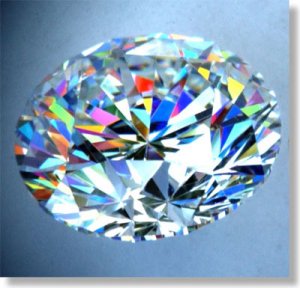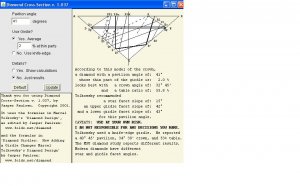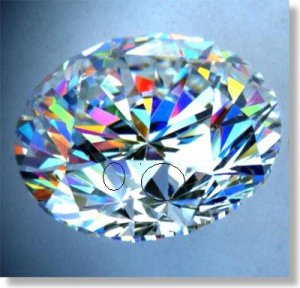- Joined
- Feb 26, 2003
- Messages
- 379
Ideal Evolution
Ever wonder why a large majority of diamonds are cut and polished as 58-facet round brilliants? Why are top quality round brilliants referred to as American Ideal, Tolkowsky Ideal or just Ideal Cut? Al Gilbertson asked those questions back in 1976, the first day on the job as faceter for an American Gem Society (AGS) jeweler. Al's subsequent jewelry career spans over 30 years as gemstone cutter, then jeweler, independent gemologist-appraiser and finally researcher in cut grading at the Gemological Institute of America (GIA). Today, Al presents us with the definitive answers to these questions in his new book just out: "American Cut - The First 100 Years."
Everyone, from those just learning about the Ideal Cut to the "diamond mavens" among us, will appreciate the significance of this historically important research on the evolution of the American Ideal Cut. The publication of Al's book presents a great opportunity to set the record straight for the diamond and jewelry industry concerning the "myths" surrounding the origins of the Ideal Cut. Al's exhaustive research is the last and best word on this subject. It has added significance due to its publication by the GIA and endorsement by GIA's president Donna Baker and chairman Ralph Destino. Donna wrote, "This important work will change your understanding of how and why diamonds are cut the way they are today." Ralph added, "The book is clearly the definitive text on the subject and, as such, will have genuine lasting value in gemological history." Clearly, GIA's endorsement of Al's research through publication of his book is an indication of their wish to set the record straight and correct the myths concerning this most important and most popular of diamond cuts.
Chief among the discoveries you will make in this great read is that the Ideal Cut of today evolved from uniquely American origins, beginning with Henry Dutton Morse of Boston in the 1860's.
"The myth is that the American Cut was created by Marcel Tolkowsky. Many believe that the cutting style he wrote about was his "ideal," and that somehow he only saw a narrow set of proportions as the best." says Gilbertson. He points out that Tolkowsky himself did not call it "ideal," and that he did indeed see other widely ranging proportions he thought had been cut to "obtain the liveliest fire and the greatest brilliancy." This should give everyone pause. Al goes on to say: "While Tolkowsky's influence did modify the American Cut's table size, he was not the first to advocate many of the proportions proposed in his book. That started in the late 1800s with Henry Morse in Boston, who wanted to cut diamonds for beauty, not weight. The story of Morse, and later Frank Wade, the industry trade press and GIA founder Robert M. Shipley's influence on cut, has, until now, been obscured by the Tolkowsky myth." Al's vision for his book was to share the real evolution of the American Cut and in doing so, "credit all of the diamond cutters and industry advocates who contributed to what many think are the best proportions to make a diamond sparkle."
I expect many in the trade to continue perpetuating the marketing myths that attribute the Ideal Cut solely to Marcel Tolkowsky and his single combination of theoretical angles. But after reading the rich history uncovered by Al's work, and perhaps doing a little research of their own using his large bibliography of references, many others will replace the myths with an even richer reality.
In talking to Al about his research for the book, I learned that GIA, AGS and the cutting firm of Lazar Kaplan (LK) were early promoters of the Tolkowsky theoretical pavilion and crown angles of 40.75 degrees and 34.5 degrees, attributing them to what they called the American Cut and the Ideal Cut. Curious about the early beginnings, Al talked to some of the early pioneers in diamond cutting, including George Kaplan. George had no recollection of LK cutting to Tolkowsky's proportions until they became active with GIA and AGS. George thought that this was in the late 30's, years after Tolkowsky's book. Al's research turned up (limited) articles from that time about LK. Supporting Kaplan's recollections, the articles did not mention the Ideal or Tolkowsky. Interestingly, the term Ideal cut, referring to a round brilliant that was cut to Morse's angles (with a smaller table than Tolkowsky), appeared in American literature decades earlier (Cattelle, 1903).
So, as Al's book carefully documents, the most important angles associated with the Ideal Cut began with Henry Morse and subsequent supporters and cutters who used his pavilion and crown angles in attaining the Ideal in round brilliant diamond cutting.
I view Al's book as a factually supported, exhaustive, historical account of the evolution of the American Ideal Cut diamond, and hope that many will read it, gaining insight into these issues.
To learn more about Al Gilbertson and the significance of his research on the evolution of the American Ideal Cut see his video on YouTube:
http://www.youtube.com/watch?v=2kc79FY0Obg
Also, go to:
http://www.podshow.com/player/psp.php?theFeed=insidegiaedu&theEpisode=87910
for an audio presentation of a reading from Chapter 2. There you will be introduced to Henry Morse, the Book's central figure.
Other views and reviews of Al's book can be found at:
http://www.jckonline.com/article/CA6495635.html?industryid=668 by Gary Roskin, JCK
http://journal.pricescope.com/Articles/53/1/American-Cut---The-First-100-Years%2c-by-Al-Gilbertson%2c-GG.aspx by John Pollard, Whiteflash
http://gemwiseblogspotcom.blogspot.com/ by Richard Wise, Wise Goldsmiths
Michael D. Cowing FGA













300x240.png)